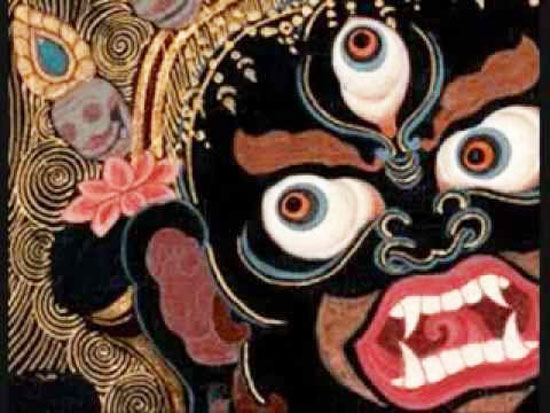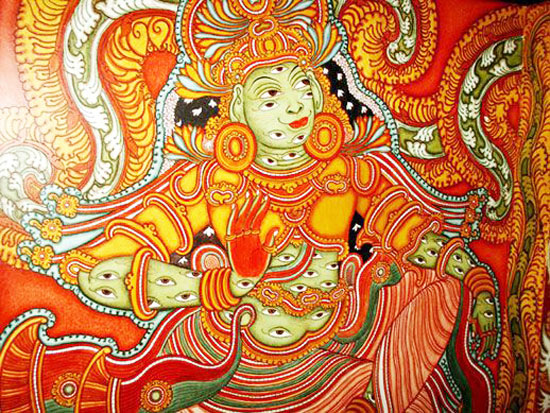Six realms of existence according to Buddhist ideology (2)
According to the Buddhist ideology, SAMSARA is considered to be DUKKHA, unsatisfactory and painful, perpetuated by desire and AVIDYA (ignorance), and the resulting KARMA. Rebirths occur in six realms of existence: heavenly, demi-god, human, animal, ghosts, hellish.
Read the first part of the article
ASURA-GATI: The Realm of Personal Demons

ASURA is a Sanskrit word that means “ugly”. Generally there are both male and female ASURA-s; males are depicted as ugly, while the females are beautiful. The very nature of an ASURA is to initiate conflicts and strife. Males generally like to fight physically using their strength. The female ASURA-s tend to fight in coverts methods, using weapons of the minds such as ignorance, jealousy, obstructiveness and affliction.
The ASURA-s are immensely strong and powerful beings who are depicted as the arch-nemesis to the DEVAS. They are renowned for their fierce envy and pride. The beings born here are filled with hate and jealousy, hence they are born as an ASURA (demon). The ASURA-s are described as: “Always desiring to be superior to others, having no patience for inferiors and belittling strangers; like a hawk, flying high above and looking down on others, and yet outwardly displaying justice, worship, wisdom, and faith — this is raising up the lowest order of good and walking the way of the ASURA-s.”
ASURA-s can either be placed in the Three Good Realms (Gods, Humans, ASURA-s) or the Four Evil Realms (Hell, Hungry Ghost, Animals, ASURA-s). The most concentration of ASURA-s can be found in the ASURA-GATI, however they are not limited to just one plane of existence. They exist in the animal, human, hungry ghost and even the Gods realms. Regardless of the realm they are in, they will pick fights and have bad tempers. They will actively try to control other entities like a supervisor, while not allowing themselves to be controlled.
ASURA-s in the human realm can include military officials and troops. The especially bad ones can come in the form of bandits, robbers, thieves, thugs and murders.
The ASURA-s in heaven constantly wage war against the heavenly army of SHAKRA. They scheme and fight morning till night, in order to seize the jeweled throne and become the heavenly king. The downfall of the ASURA is that they are strong beyond a doubt, but lack the power to defeat any heavenly beings.
ASURA-s exist in the animal realm as well. Tigers, lions, snakes, eagles and wolves are examples of ASURA-s that exist in the animal realm. They often bully other animals and kill them for food.
ASURA-s in the hungry ghost realm exist to bully the ghosts within this realm. The ghosts in this realm are unreasonable to being with, but ASURA-s are even more unreasonable and have huge tempers.
They are given great blessings at birth, but lack heavenly authority. They fight for control of power and advantages, but fail to obtain them because they lack the authority too. The modern world is filled with ASURA-s, all fighting and struggling; mostly due to the “dog eat dog” mentality that the ASURA-s have created. ASURA-s are so hard-headed that they can fight indefinitely for thousands of years without growing tired.
They are forced to pay retribution wherever the laws of KARMA desires them too. They will often get dragged to many lower and higher levels to pay off the debt of KARMA.
If one is to hang around with ASURA-s, will become closer with them. Getting closer with an ASURA is a sure way to end up in the realm of ASURA-s.
MANUSYA-GATI: The Human Realm of Personality and Duality
The realm of the ASURA-s is filled with evil beings, but what of the human realm? Humans have a dualistic nature, they can be both good and evil. Harmony or balance is what defines us as a realm. People are naturally harmonious, capable of getting along with anyone and anything.
The human realm is the dimension which presents the best opportunities for a being to escape SAMSARA. Enlightenment is within the cusp of all humans, yet only very few attain the ultimate spiritual liberation. Birth in this realm belongs to those that have passion, doubt and desire, the Buddhists say.
Sometimes souls are trapped within the human realm because they are KARMA neutral, so they do not ascend nor descend to different realms, Buddhists believe. Beings in this realm acquire merits and offences, based on their overall life. A being with many merits will often rebirth into a rich and distinguished family, whereas heaving large amount of offences will lead to rebirth into a poor family.
Between the extremes of good and bad, there are many thousands of distinctions a human can gain. A human with heavy affiliation with bad will ultimately turn into a hungry ghost, whereas a human with lots of collected good will ascend into a god.
As a human, we have complete control over our destiny. We are not ignorant like the beings in other realms. We know what is good and what is bad. The consequences of our actions lead to our fate.
DEVA-GATI: The Realm of the Gods
The DEVA realm is populated by godlike beings who have great power, wealth and long lives. They live every day in happiness and splendor. They do however grow old and die, like all of creation, Buddhists say. Their privilege and rank makes them blind to suffering of others, so despite their gifts, they have neither wisdom nor compassion, according to the Buddhist ideology. The DEVA-s have mastered SAMARA and will ultimately be reborn in one of the six heavenly realms. The beings here have cultivated the five precepts and the ten good deeds, so they obtain the blessings and rewards of the heavens as a result.
In total there are three types of heavens, according to Buddhists. These include desire, form and formless realms. The heavens of DEVA-s can be called the Desire Realm Heavens, which can be divided into Six Heavenly Realms and one BRAHMA Heaven.
The Six Desire Realms
The Realm of the Four Heavenly Kings
The MANUSYA realm is located under the first of the six heavens within the Desire Realm. The first heaven of the Desire Realm is ruled by the Four Heavenly Kings. The exact location of this heaven was hypothesized to be halfway up Mount Sumeru, meaning that the bottom half of the mountain is within the MANUSYA Realm. The parts of this heaven located on the North, South, East, and West sides of Mount Sumeru are governed by the Four Heavenly Kings, as are the four continents of our world: PURVAVIDEHA to the East, JAMBUDVIPA to the South, APARAGODANIYA to the West, and UTTARAKURU to the North.
The souls that exist within the Heaven of the Four Heavenly Kings have an average lifespan of 500 years, relative to themselves. An entire day in heaven is equivalent to 50 years on Earth. This would mean that the average adult living up to 70 in human years would live 1,277,500 years in this realm.
TRAYASTRIMSHA: The “Don’t Know” Heaven

TRAYASTRI is a Sanskrit word, roughly translated to, “Don’t Know Heaven”. TRAYASTRIMSHA on the other hand is a Sanskrit word meaning, “thirty-three”; this is the number of heavens present in this heaven. TRAYASTRIMSHA Heaven has four heavens orbiting around it, within the North, South, East and West quadrants of space. Within each quadrant there are eight different heavens, making a grand total of 33 heavens within this realm, including itself.
SHAKRA, also known as yin tuola ye or Indra in the SHURANGAMA MANTRA, resides as the king within this realm. In China he is known as the Jade Emperor. Shu-Jing, The Book of History, refers to him as the Supreme Lord, “Bathe and observe purity in order to worship the Supreme Lord.” SHAKRA resides in the centre of TRAYASTRIMSHA, overlooking the orbiting realms near it.
YAMA: The “Time Period” Heaven
YAMA is a Sanskrit word meaning, “time period”. In this realm, the gods are so happy that they rejoice and sing of their bliss all day long. They sing: “How happy I am! I’m so happy!”, Buddhists say. They are joyful throughout all the six periods within a day. This is why the realm is called “time period”, because the gods here are happy every time period.
TUSHITA: The “Happiness and Contentment” Heaven
TUSHITA is a Sanskrit word meaning “happiness and contentment”. The gods here are always happy and satisfied with life in every aspect. The gods in this realm do not worry or care about anything because they have no afflictions or worries.
NIRMALARATI: The Heaven of “Transformation of Bliss”
NIRMALARATI is a Sanskrit word meaning “Heaven of the transformation of bliss”. In this realm the gods create happiness through transformations. The realm of “happiness and contentment” one stays blissful and happy in any situation. The beings here are aware of unhappy situations, this leads them to transform themselves, creating happiness and pure love.
PARANIRMITA-VAVARTIN: The Heaven of “Transformation of Others’ Bliss”
The gods in this heaven do not have any bliss of their own, they do however take bliss from other beings within heavens. This heaven also has many demons living in it, sucking bliss away from the gods within the many realms.
BRAHMA Heavens
The BRAHMA Heavens include the Great BRAHMA (MAHABRAHMA) Heaven, the Multitudes of BRAHMA (BRAHMAKAYIKA) Heaven, and the Ministers of BRAHMA (BRAHMAPUROHITA) Heaven. Beings of the Six Desire Heavens and the BRAHMA Heavens practice the five precepts and the ten good deeds.
Note that each of the six realms of existence, according to the Buddhist ideology, has a resident Buddha, through whom the inhabitants can hear the DHARMA — this may reflect the MAHAYANA Buddhist notion that the ultimate Buddha-nature (DHARMAKAYA or SUCHNESS) pervades the entire universe.
yogaesoteric
May 21, 2019
